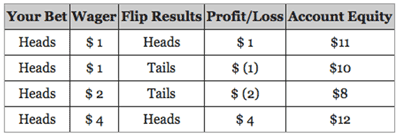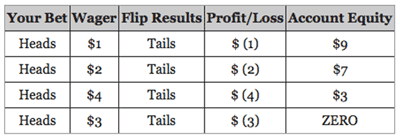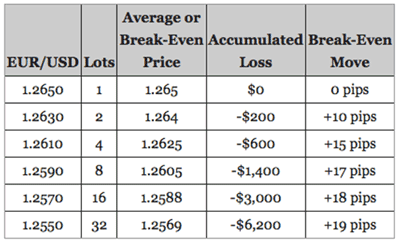Can I interest you in a trading strategy that is theoretically 100% profitable? Most traders will probably reply with a resounding, "Yes!" Amazingly, such a strategy does exist and dates all the way back to the 18th century. This strategy is based on probability theory, and if your pockets are deep enough, it has a near-100% success rate. "Deep pockets" as in infinite wealth, that is.
Known in the trading world as the martingale, this strategy was most commonly practiced in the gambling halls of Las Vegas casinos and is the main reason why casinos now have betting minimums and maximums, and why the roulette wheel has two green markers (0 and 00) in addition to the odd or even bets.
The problem with this strategy is that in order to achieve 100% profitability, you need to have very deep pockets. In some cases, they must be infinitely deep.
Unfortunately, no one has infinite wealth, but with a theory that relies on mean reversion, one missed trade can bankrupt an entire account. Also, the amount risked on the trade is far greater than the potential gain.
Despite these drawbacks, there are ways to improve the martingale strategy. In this article, we'll explore the ways you can improve your chances of succeeding at this very high-risk and difficult strategy.
What Is the Martingale Strategy?
Popularized in the 18th century, the martingale was introduced by a French mathematician by the name of Paul Pierre Levy. The martingale was originally a type of betting style that was based on the premise of "doubling down." Interestingly enough, a lot of the work done on the martingale was done by an American mathematician named Joseph Leo Doob, who sought to disprove the possibility of a 100% profitable betting strategy.
The mechanics of the system naturally involve an initial bet, however, each time the bet becomes a loser, the wager is doubled such that, given enough time, one winning trade will make up all of the previous losses.
The introduction of the 0 and 00 on the roulette wheel was used to break the mechanics of the martingale by giving the game more than two possible outcomes besides the odd versus even, or red versus black. This made the long-run profit expectancy of using the martingale in roulette negative, and thus destroyed any incentive for using it.
To understand the basics behind the martingale strategy, let's take a look at a simple example.
Article Continues on Page 2
|pagebreak|Suppose that we had a coin and engaged in a betting game of either heads or tails with a starting wager of $1. There is an equal probability that the coin will land on head or tails and each flip is independent, meaning that the previous flip does not impact the outcome of the next flip. As long as you stick with the same directional view each time, you would eventually, given an infinite amount of money, see the coin land on heads and regain all of your losses, plus $1. The strategy is based on the premise that only one trade is needed to turn your account around.
Assume that you have a total of $10 to wager, starting with a first wager of $1. You bet on heads, the coin flips that way, and you win $1, bringing your equity up to $11. Each time you are successful, you keep on betting the same $1 until you lose.
The next flip is a loser and you bring your account equity back to $10. On the next bet, you wager $2 in the hope that if the coin lands on heads, you will recoup your previous losses and bring your net profit and loss to zero. Unfortunately, it lands on tails again and you lose another $2, bringing your total equity down to $8.
So, according to martingale strategy, on the next bet, you wager double the prior amount, or $4. Thankfully, you hit a winner and gain $4, bringing your total equity back up to $12. As you can see, all you needed was one winner to get back all of your previous losses.
However, let's consider what happens when you hit a losing streak:
Once again, you have $10 to wager, with a starting bet of $1. In this scenario, you immediately lose on the first bet and bring your balance down $9. You double your bet on the next wager, lose again, and end up with $7.
On the third bet, your wager is up to $4 and your losing streak continues, bringing you down to $3. You do not have enough money to double down and the best you can do is bet it all. If you lose, you are down to zero, and even if you win, you are still far from your initial $10 starting capital.
Trading Application
You may think that the long
string of losses, as in the above example, would represent unusually bad luck,
but when you trade currencies, they tend to trend, and trends can last for a
very long time if you are caught in the wrong direction.
The key with martingale, when applied to trading, is that by "doubling down," you essentially lower your average entry price. In the example below, at two lots, you need the EUR/USD to rally from 1.263 to 1.264 to break even.
As the price moves lower and you add four lots, you only need it to rally to 1.2625 instead of 1.264 to break even. The more lots you add, the lower your average entry price. Even though you may lose 100 pips on the first lot of the EUR/USD if the price hits 1.255, you only need the currency pair to rally to 1.2569 to break even on your entire holdings.
NEXT: Why Martingale Works Better with Forex
|pagebreak|This is also a clear example of why deep pockets are needed. If you only have $5,000 to trade, you would be bankrupt before you were even able to see the EUR/USD reach 1.255. The currency may eventually turn, but with the martingale strategy, there are many cases when you may not have enough money to keep you in the market long enough to see that end.
Why Martingale Works Better with FX
One of the
reasons why the martingale strategy is so popular in the currency market is
because, unlike stocks, currencies rarely go to zero. Although companies easily
can go bankrupt, countries cannot.
There will be times when a currency is devalued, but even in cases where there is a sharp slide, the currency's value never reaches zero. It's not impossible, but what it would take for this to happen is too scary to even consider.
The FX market also offers one unique advantage that makes it more attractive for traders who have the capital to follow the martingale strategy: The ability to earn interest allows traders to offset a portion of their losses with interest income.
This means that an astute martingale trader may want to only trade the strategy on currency pairs in the direction of positive carry. In other words, he or she would buy a currency with a high interest rate and earn that interest while, at the same time, selling a currency with a low interest rate. With a large amount of lots, interest income can be very substantial and could work to reduce your average entry price.
The Bottom Line
As attractive as the martingale
strategy may sound to some traders, we stress that grave caution is needed for
those who attempt to practice this style of trading. The main problem with this
strategy is that oftentimes, a seemingly sure-fire trade may blow up your
account before you can turn a profit or even recoup your losses.
In the end, traders must question whether they are willing to lose most of their account equity on a single trade. Given that they must do this to average much smaller profits, many feel that the martingale trading strategy is entirely too risky for their tastes.
By Kathy Lien of KathyLien.com























